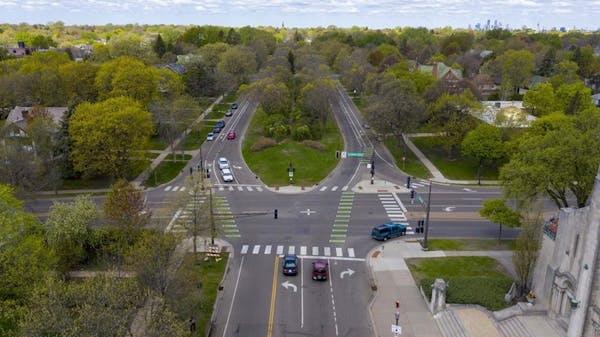Hundreds of people jammed the community room at Palace Recreation Center Thursday night to boisterously voice their support or opposition to a plan to run a regional trail down St. Paul's historic Summit Avenue.
And while most arguments for or against the separated bike trail repeated what's already been said at information sessions and open houses, the hearing before the Parks and Recreation Commission was the public's first chance to weigh in. And dozens did — many to raucous applause from like-minded allies.
Perhaps the loudest and most sustained applause of the evening came from the anti-trail crowd, following a question from Parks Commissioner Andy Flamm to Mary Norton, a city landscape architect with the Parks and Recreation Department.
"You've done a great job of making a plan based on the initial assumption that a regional trail is wanted in the area," Flamm said. "What I wonder is, was it ever determined that that's what the residents of St. Paul want?"
A safer, separated trail is certainly what resident Will Mattessich said he wants. When he was younger, he rode his bike to his job at Grand Ole Creamery. Now, he commutes on Summit to his work downtown.
"I am very excited for the city to build this very common-sense plan for a safer Summit Avenue," Mattessich said. "Summit Avenue connects us. Summit Avenue is not just an amenity. ... Summit Avenue is a transit thoroughfare, and the city has extensively studied the way people use Summit Avenue to come up with this way to make it safer for alternative modes of transit."
But Gary Todd, a Summit resident, has opposed the plan since it was introduced a year ago. His group, Save Our Street, repeatedly has hammered on the fear that construction of the bike path could jeopardize nearly 1,000 trees. City officials say estimates show about 200 trees would be at risk.
On Thursday, Todd asked the city to pause its planning until questions about trees, safety and costs can be answered more definitively.
"Summit Avenue is too valuable an asset for the city of St. Paul and the state of Minnesota. You shouldn't risk irreversible change and damage until the impacts are fully understood," Todd said. "The risk to the historic tree canopy on Summit Avenue needs to be honestly evaluated before doing any planning."
Planning for a regional trail down Summit, which officials say would create a better and safer east-west connection to the region's bicycling system, began as city leaders started talking about the need to rebuild the crumbling roadway.
The mansion-lined street annually is pocked with potholes, which city officials say will continue to worsen until Summit is completely reconstructed. Portions of Summit's underlying infrastructure — sewer, water and gas lines — have not been replaced in more than 100 years. A complete rebuild would cost an estimated $100 million. As yet, no funding for the project has been approved.
Because officials say it makes sense economically to do such projects at the same time to keep disruption to a minimum, the city canceled plans to do a mill and overlay on a half-mile of Summit until the fate of the regional trail is decided. A trail would cost about $12 million, with the city receiving some state help if the plan is approved locally and by the Metropolitan Council.
If approved and funded, city officials have said the road rebuild and the regional trail would be phased in over at least a decade.
Trail supporters have said repeatedly that a raised trail in Summit's existing right of way — but separated from traffic by a curb and buffer — is needed to replace the street's decades-old painted bike lanes that offer no protection from speeding or distracted motorists. It would harm no more trees than the necessary road reconstruction without a trail, Public Works Director Sean Kershaw has said.
Trail opponents say the city would better protect mature trees close to the roadway — as well as cyclists — by narrowing and repaving Summit and brightly repainting its bike lanes.
The Parks and Recreation Commission took no action on the trail proposal Thursday. Next, it will go to the city's Transportation Committee and Planning Commission for review and recommendation, before returning to the parks commission for its May meeting.
The commission then will review the plan and make a recommendation to the City Council.
Carolyn Parnell, 'trailblazer' who served as Minnesota's first IT commissioner, dies


